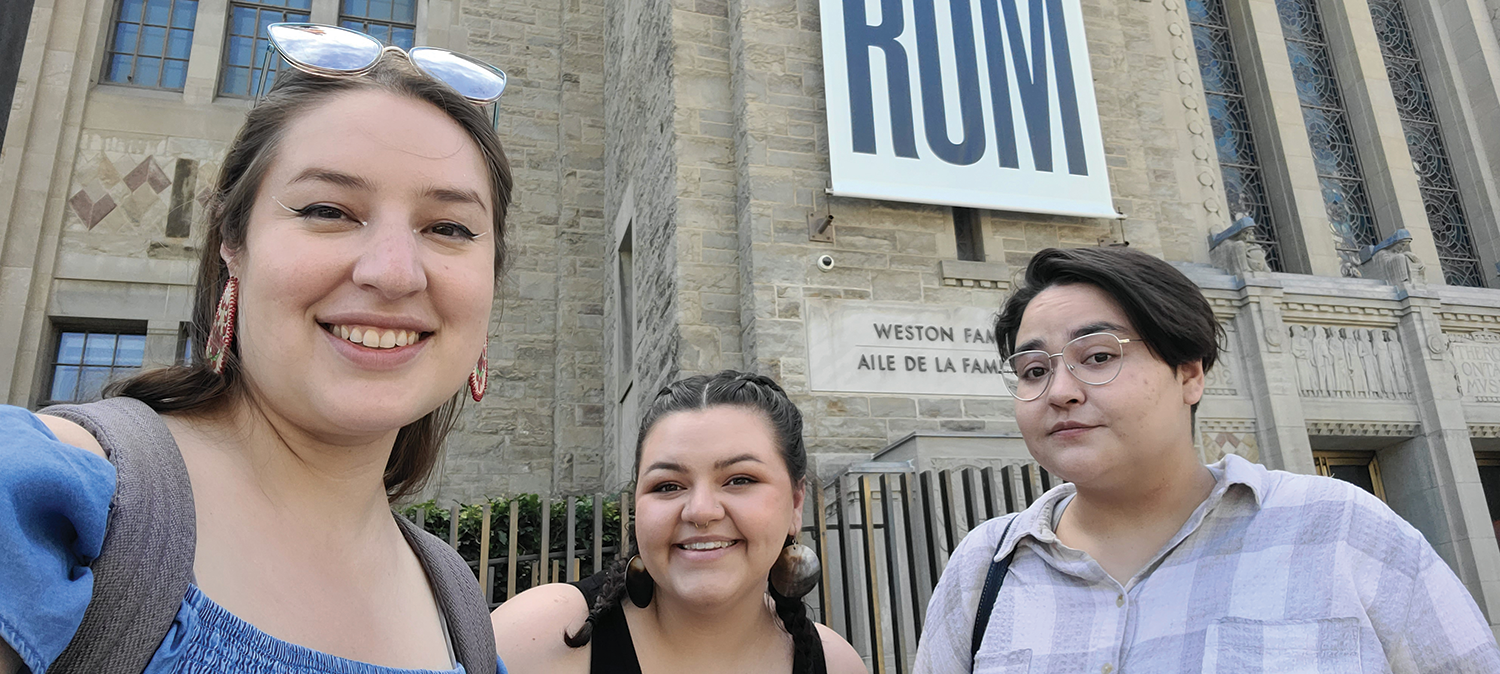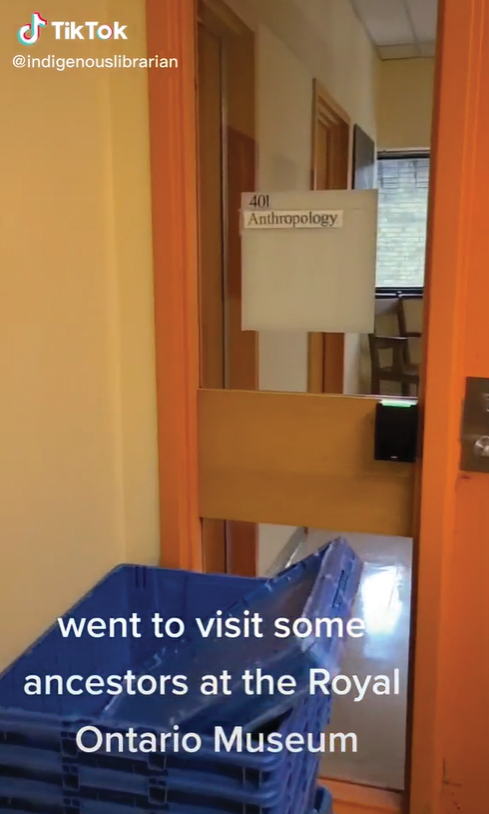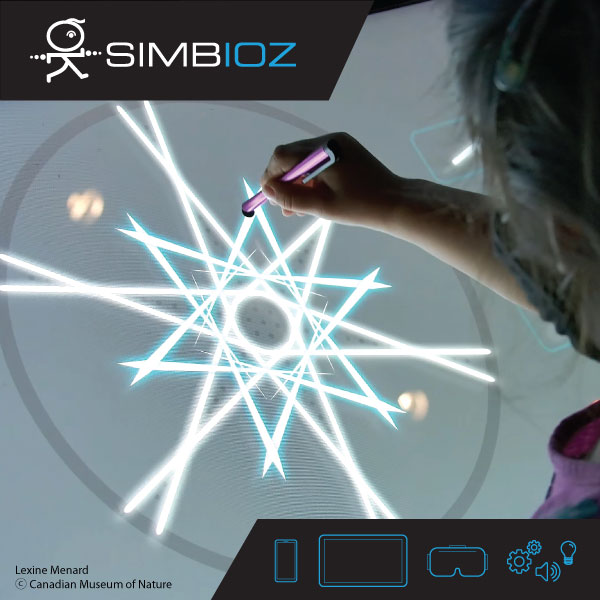“It is not the ghosts of old dances”
Locating Relationality and Indigenous Cultural Memory in Museums
Interview with Jessie Loyer

Jessie Loyer is Cree-Métis and a member of Michel First Nation. She is the Anthropology and Indigenous Studies liaison librarian and assistant professor at Mount Royal University. As an academic librarian, Jessie’s research looks at Indigenous perspectives on information literacy, supporting language revitalization, and developing ongoing, reciprocal research relationships using nêhiyaw and Michif conceptions of kinship. She uses her @IndigenousLibrarian account to teach more than 29,000 followers about Indigenous perspectives on information systems, repatriation, and reflections on decolonizing initiatives.
CMA Reconciliation Program Manager Stephanie Danyluk spoke with Jessie Loyer on how relationality intersects with collections management and the role of museums in confronting and disrupting their colonial legacy.
Can you describe how your work on Indigenous information literacy intersects with museology?
My work focuses on relationality broadly in cultural memory institutions. My work started thinking through Indigenous information literacy: how people make sense of information, how we learn how to manage it, create access to it, all of those broad concepts, with the sense that any Indigenous information literacy is going to be concerned with far more than print. I do not work in museums, but my relationship with them is as another kind of collections holding space.
My work focuses on relationality specifically, from a Cree perspective. Using wahkotowin, how do we think about being in good relationship, not only with people, but with everything around us? I see that as extending to our collections as well. The librarian in me is thinking: what is our relationship, our relationality with information? With museums, specifically, what is the relationship with our collections, the objects or cultural belongings that we hang on to: how we think about them, how we care for them, how they are connected to their other relatives? 
Jessie Loyer taking a selfie in front of the ROM with Taya Jardin and Jas M. Morgan.
In relation to collections, can you expand on this relationality and connection to information, material culture, and intangible cultural heritage?
It is having to think differently about material culture, because in many cases, stories have been separated. Where we have a story that should have been holistically together with, for example, a song or a story that exists seasonally, and then the material culture that goes with it, like beadwork, or drums or teepees, or regalia, a lot of times, those memory institutions that exist in Indigenous knowledge systems got parsed out, depending on what institution acquired bits of them. For example, you have a museum saying, “We love this teepee cover. We’re taking that or we’re buying that.” And then we have an anthropologist who sat with someone and wrote down the story, and then the anthropologist’s field notes or recordings end up in archives. So those things get separated.
You really can see the way that complex knowledge systems have experienced epistemicide. You see that destruction happen as items are taken away, as songs are deliberately not sung in order to safeguard the younger generation from being punished for speaking or singing in their language. As Maria Campbell explained to me, we are trying to reclaim these knowledge systems, there are still puzzle pieces that are missing. That is why we need everyone involved in the process because someone will remember a song and then a museum will have a piece of regalia or a pottery or a ceremonial item that can be returned. We can turn to archival sources to get a fuller sense of what the knowledge systems looks like, while keeping that continuity.
It is really heartbreaking to think about how so much of why we now struggle to articulate those ceremonies or those important parts in Indigenous life are because these things have been deliberately dissected and taken into different institutions. For me, archives, museums, libraries--they all have to exist together, because they are all bringing different puzzle pieces together to help rebuild these knowledge systems. As a librarian who does information literacy, that is really important to know, because that is how knowledge transfer happens. That is how pedagogy happens. That is the center of knowledge transfer for so many Indigenous communities. When all of these components of intangible heritage and material culture are together, that is where we really that full expression of cultural transfer. It is less about the showiness of having one piece of ceremonial regalia.
Although I’m a librarian and my work is largely in academic libraries, I must think about all these other cultural memory institutions, because that is where all the rest of the story ends up going. So that is the start of that intersection.
What are some of the major considerations for GLAM spaces as they move to action reconciliation and UNDRIP? Can you expand on where you have seen collaborative work in these spaces?
I think reconciliation is tough because it ignores the rage that people feel, the sadness, the grief. I think one of the big things that museums do not necessarily understand is that huge undercurrent of rage and grief that Indigenous people bring into museums. Theft has characterized museums and their relationships with Indigenous people. And we want to jump ahead to “you love being here” and “we love the museum.” And we are not there yet.
I have good feelings about museums, but even in those spaces, it is terrible, awful grief. A lot of the time, you are standing in front of something that is so beautiful and so far from its home, or you are standing in front of something that you know that people from your own community have never seen. And they would be better for having seen it and knowing what our communities had.
I think about as a kid, going to the Royal Alberta Museum with my parents to see beautiful regalia. Sometimes it was made by people we knew, sometimes they had gifted that to the museum, and sometimes it had been taken away from them. But it was a process of actually visiting with relatives and acknowledging the animacy of these things.
There is so much wealth held by museums; things that are beautiful, intricate components of culture, that are no longer part of cultural practices, or that have been taken out of a community.
The truth component of the reconciliation needs to happen, and I think that museums are really loath to do it because it means looking at their own complicity. It means thinking about the way that boards are made up of non-Indigenous people. It means looking at the ways we assess if we are doing a good job come to us from non-Indigenous perspectives. 

Screenshots from Loyer's most viewed and most recent videos (September 26, 2021 and June 14, 2022 respectively). The first offers a short, but impactful, insight into the complexity of cataloging Indigenous knowledge into Western systems, while the second features her visit to the Royal Ontario Museum.
What do museums need to consider to create safe, ethical, culturally welcoming to provide for that kind of truth?
Museums have not necessarily reckoned with that rage that people feel. It is wonderful to be welcomed into a museum, but I think the next step is, what are you going to do with that history? What are you going to do with people’s anger and sadness that these things have been stolen from them, regardless of how they ended up in collections, regardless of their provenance? That is a big part of when we talk about a culturally safe space--how do we reckon with really negative effects?
The historical ego of institutions really gets in our way. We think of ourselves as being service oriented. You know, we are serving the public, we are providing access. I think that often gives us a sense of meaning, certainly. But it means that we are always positioning ourselves as service institutions, when in many cases, we do not function like that to those communities, we do not provide access, we do not provide service. I think it really is taking a step back and identifying who does not appear in our spaces. Because the dude on the street who went to residential school, whose Granny’s stuff is in your museum probably has a right to be there. He’s visiting that stuff that belongs to him and belongs to his family.
What do you see as tangible steps museums can take to reckon with this colonial history?
Thinking about how items came to museums from a very limited sense of singular white man’s joy and how we ended up caring for them in museums: what do we do to disrupt that?
How we care for those items sometimes means hanging on to them, sometimes means repatriating sometimes means destroying them--it really depends on what it is. Ceremonial objects have spiritual power, have animacy. That relationality means this is not just something under glass, but rather a relative to be cared for, to be fed, to be part of a living space. And how they how they should be cared for varies within different contexts.
From a records management perspective, the ability to allow the lifecycle to be ended, I think is really helpful, because sometimes we are just maintaining ghosts. We are hanging onto things because we think that they have value, when maybe their most important value is allowing that knowledge transfer to end.
For many museums, maybe our process is less about ownership and more about stewardship. How do we enable access to the collection? Where can it go and be used in a very specific way, in the cultural context that it was intended to be? That, to me is a really exciting way of thinking about assessment as use, as right of access in that way where a collection is alive. It is not the ghosts of old dances, but it is being used, it is being danced in.
M
